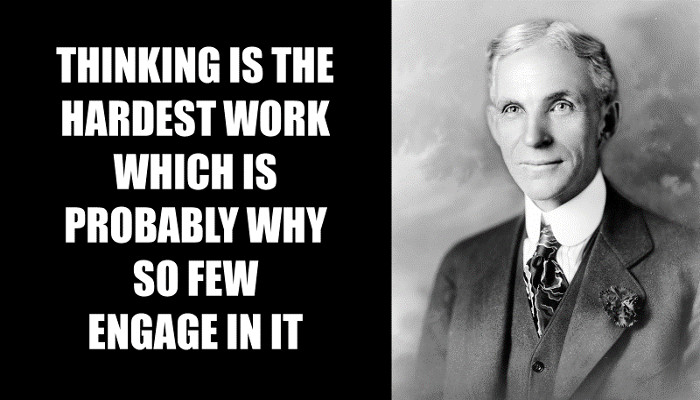
The request comes in similar forms. “Ron, can you “bang out,” “throw down,” “slap together,” or “crank out,” a few PowerPoint slides for me?” Evidently, sharing one’s brilliant insight is as simple as communicating through bullet-speak.
Bullet-speak was developed at the turn of the twenty-first century. It’s a communicable disease that spreads from co-worker to co-worker as employees react to short-term requests that deserve longer-term reflections. The disease spreads effortlessly because bullet-speak requires very little skill. It only requires a host that can operate a mouse and pound hamhandedly on a keyboard to spray bullets with abandon. Rat-a-tat-tat.
Bullet-speak is easy. Storytelling is hard. Bullet-speak thrives on mindless reaction. Storytelling emerges from thought. Therefore, if employees are to have any shot at becoming better communicators, they’ll have to do more thinking. And therein lies the problem.
Henry Ford best described the monumental task before them. “Thinking is the hardest work there is, which is probably the reason why so few engage in it.” 1
Until organizations start rewarding the hard work necessary to convey meaning, they’ll continue to remain stuck in the language of bullet-speak.
But that would require change.
Rat-a-tat-tat.
And such a change would be terrifying.
Rat-a-tat-tat.
Business storytellers need their leaders to stand up for them–leaders like General James Mattis, the former commander of U.S. Central Command who once said that “PowerPoint makes us stupid.” 2 Organizations need leaders with guts, like Amazon’s Jeff Bezos, who not only banned PowerPoint, but he replaced it with something radical. He requires his employees to “…compose 6-page narrative memos, and he starts meetings with quiet reading periods—’study halls’—in which everyone reads the memo from beginning to end.” 3
As a storyteller, I’d welcome such an opportunity. But to be fair, I can also see how terrifying it would be for someone who had successfully navigated their career through a mastery of bullet-speak.
Can you imagine what is was like for those first Amazonians to present using subjects and predicates instead of bullet-speak? And while that change may have elevated their blood pressures, can you also imagine what it was like when they bared their souls before the ‘study halls’ as peers read those six pages in silence?
Since I’ve never been a part of one of these meetings, I can only imagine what would happen next. While It’s likely that the team will have a better dialog about the topic, I also see a potential side-benefit. Team building could emerge as future presenters reached out for help to craft better prose.
But alas, that would require the hardest work there is, which is why most companies will likely continue down the same bullet-ridden path.
Rat-a-tat-tat.
Photo Credit: Library of Congress, Henry Ford, photo taken by Hartsook circa 1919. http://www.loc.gov/pictures/item/94506959/